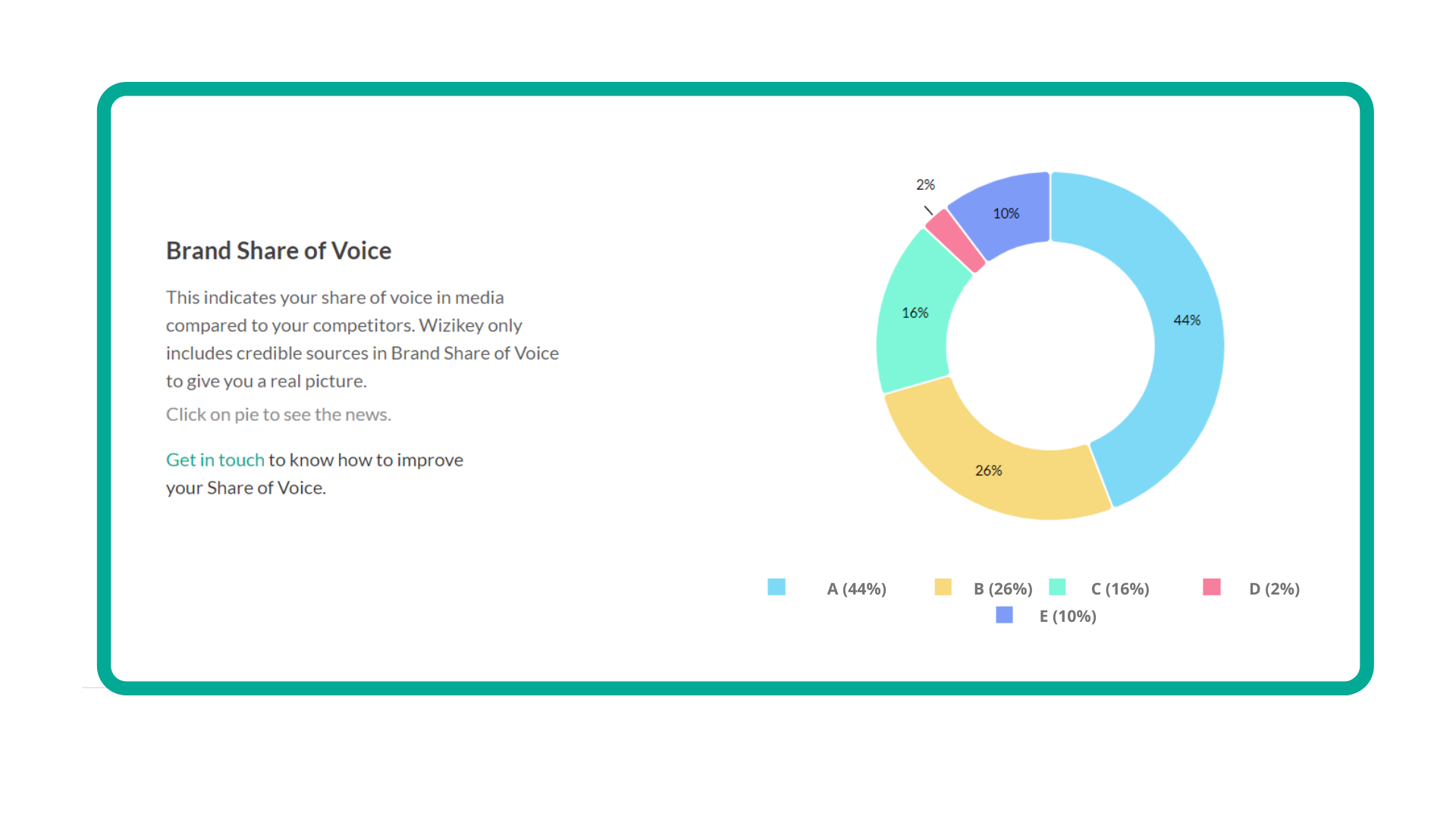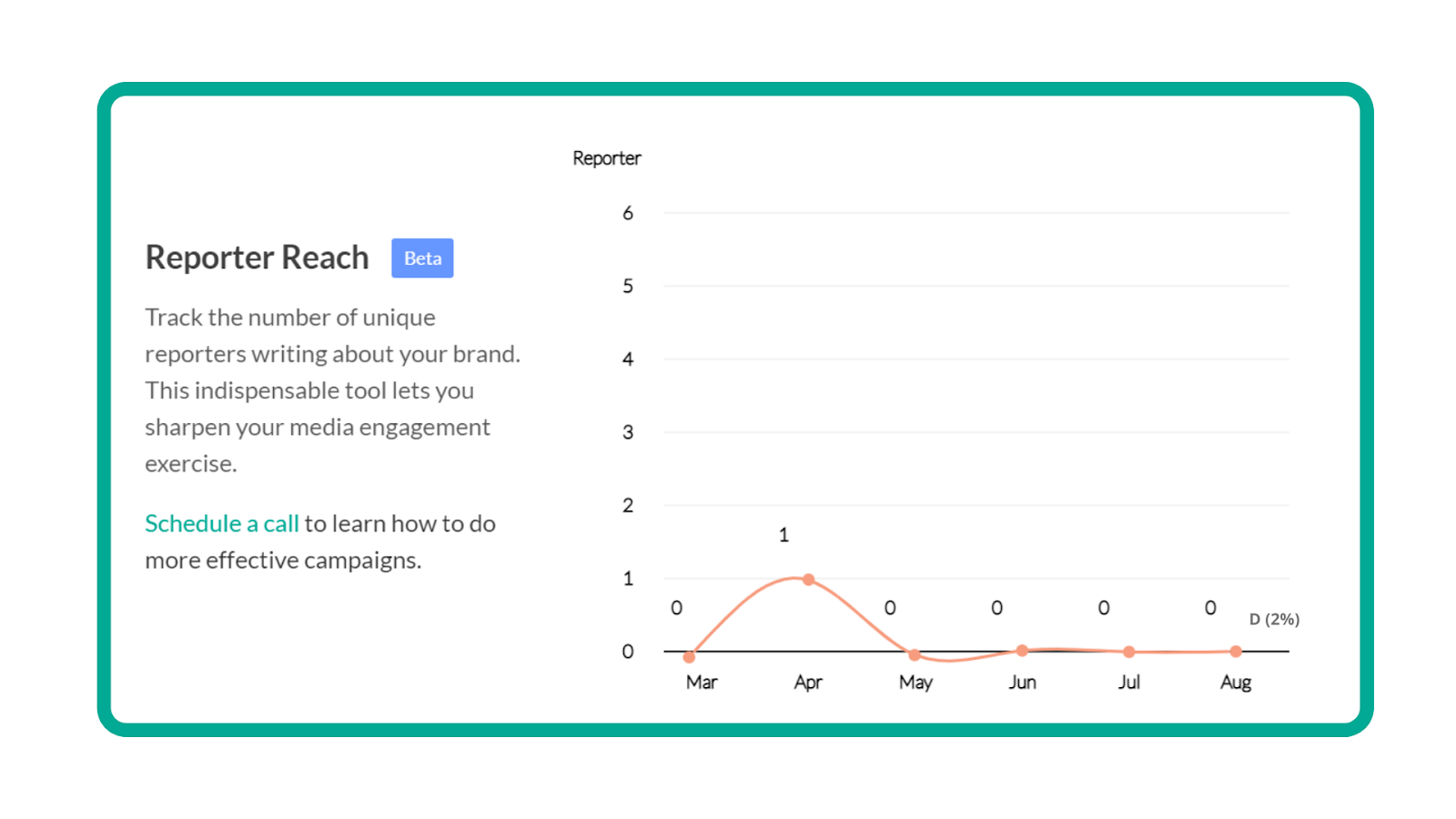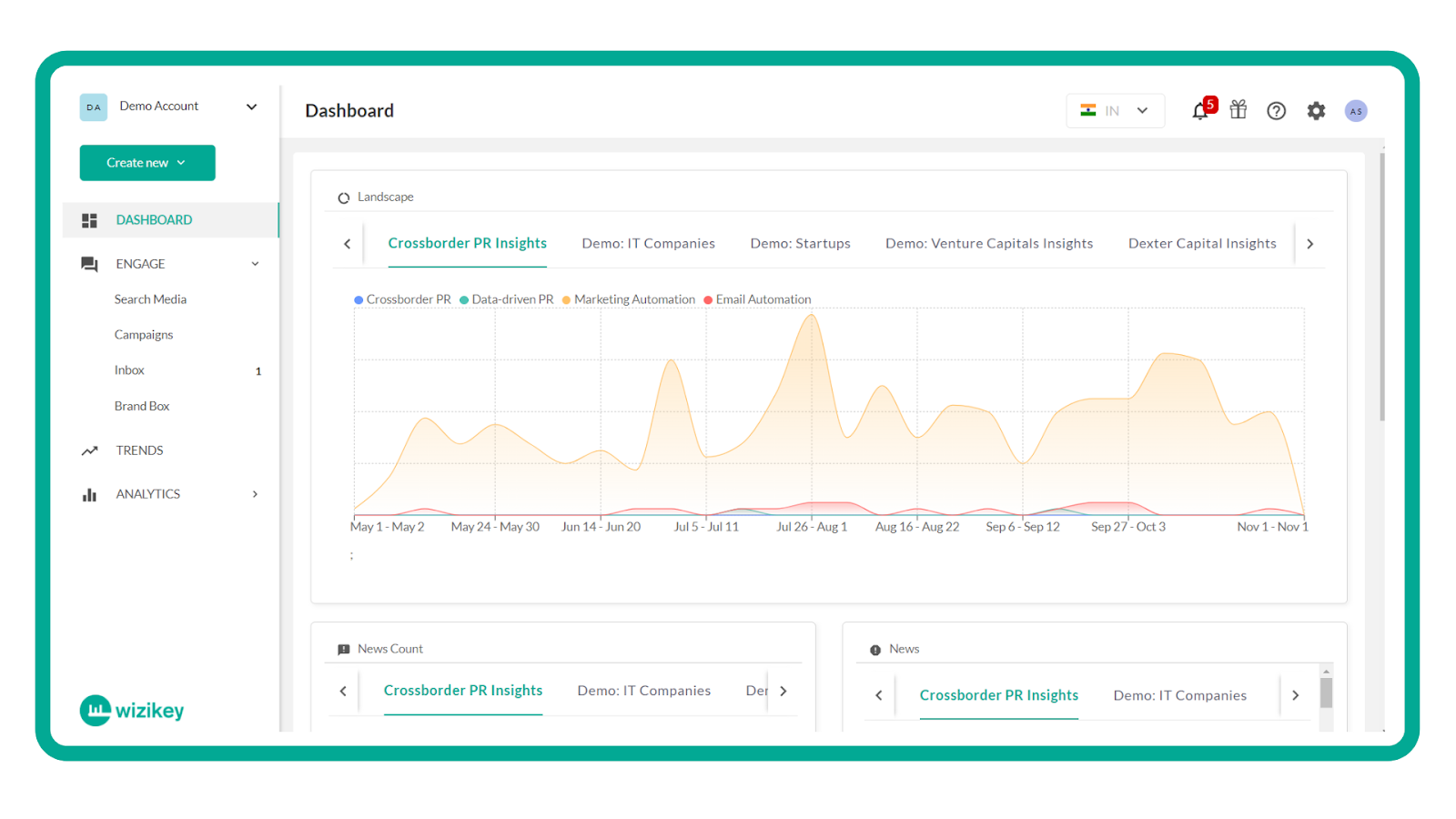Written by Team Wizikey
November 1, 2021
The Ultimate Media Monitoring Guide for 2022
Media monitoring is a business intelligence tool that helps companies keep up-to-date with, and respond to current media trends.
Have you ever wanted to know what’s being said about you in the media? This is where media monitoring comes in. Media monitoring is the process of identifying and tracking your key company mentions across the media. This practice of analyzing what is being said about a brand, individual, organization, or product in the media is known as media monitoring.
The simplest way to describe its function is as a business intelligence tool that helps companies keep up-to-date with, and respond to current media trends. The process involves the collection, analysis, and distribution of relevant information to all relevant functions of the organization.
Benefits of media monitoring
Media monitoring has been used for optimization and brand building for quite some time now. Today, it has become an important and useful discipline that corporate communications professionals use.
Staying updated with the latest news and developments is essential to keep your organization ahead in the competition. Media monitoring software keeps you updated and informed.
With a highly fragmented media ecosystem, many people are realizing the importance of media monitoring. It can be used to improve your PR campaigns and brand perception.
Make informed decisions
With the ever-evolving industry, one has to gather the pulse of the industry that they are in. You cannot shoot arrows in the dark. Media monitoring allows you to track your competitors, your own journey, customers. Starting from the New York Times to local papers from all over the world. You can find out what the media is saying about your brand online and help you make informed business decisions.
In fact, successful companies are the ones who take advantage of their competitors’ mistakes and shortcomings. On the other hand, even the most successful companies lose customers if they fail to react to the market changes.
Creating a positive brand perception
Media monitoring is beneficial for organizations that want to build trust and understand how they are perceived by their target audiences.
Media monitoring is the process of tracking trending news stories. It helps you create new, relevant, and timely content. Thus, helping you identify emerging trends in your industry.
Identifying potential threats and opportunities
Media monitoring is an essential pre-emptive strategy that helps an organization identify potential threats before they reach their radar. It helps you stay ahead of your competition by anticipating future events rather than reacting to them. Similarly, there are many opportunities too like coverage opportunities, product launches, etc. Gathering the information can then be used as a guide for future PR strategies and tactics to gain the best ROI from every campaign executed.
With more mentions comes more people paying attention to your brand. It’s important to not only monitor when you are hit with negative news but potential opportunities with positive coverage as well.
Weaving impactful brand stories
Media monitoring has shifted the game when it comes to crafting brand stories. Gone are the days when you could only rely on word-of-mouth to create awareness for your brand.
Your way of identifying trends will help you better predict which areas to focus on. And when done right, media monitoring will enable you to tell better brand stories through compelling content.
Identify the movers and shakers
When you monitor your media landscape, you can easily identify the most influential journalists writing about you and your competitors. Thus, enabling you to successfully pitch them on your latest piece of content. Even better, monitoring is more powerful because you can identify journalists with large social media followings who can amplify your voice.
Advantage of a Media Monitoring Partner
If you’re using media monitoring to craft your PR strategy, it’s essential to use the right tools to make sure it’s a smooth process. Effective media monitoring ensures your brand stays at the top of everyone’s mind.
These days you have to keep your finger on the pulse of what’s being written about you. But who has time to read literally everything that’s published? Thankfully, there are media monitoring partners to do it for you. They monitor everything that gets published about your brand, product, etc. What’s more, they even compile the figures into easy-to-read reports which you can utilize to make informed decisions. The right partner will keep you up-to-date on your brand without spending hours searching or reading printouts.
Media Monitoring: Who needs it?

Every organization that cares about its brand, reputation, and wants to build trust should have a media monitoring system in place. If your organization interacts with the public, you ought to know the pulse of the outside world. Get a view of how you’re being represented, and get ahead of opportunities or threats that could impact your organization.
Reputation management, monitoring specific industry news, competitor tracking, and benchmarking has always been the core activities of brands.
Organizations with these three primary goals will need media monitoring:
- Awareness – to be aware of all relevant data related to an organization’s brand
- Respect – to understand how others view an organization
- Control – to systematically improve the quality of an organization’s image over time.
If you fall under any of these categories, you definitely need to have media monitoring tools in place:
- Computer Software
- Information Technology
- Marketing and Advertising Services
- Financial Services
- Internet
- Hospital & Health Care
- Computer Hardware
- Telecommunications
- Education Management
- Insurance
Areas to monitor
Now that you know the relevance of media monitoring, your obvious question would be, where do I start? We will break it down into simpler components to help you understand it.
Retrospect on your own brand
Today, media monitoring is about how does your brand look in your mentions? Was the tone of the article positive? Which websites are writing about you?
In brief, you need to first start monitoring your brand and its trajectory, things that worked and things that did not. A deeper look into your own brand will reveal:
- Who are the journalists writing about you?
- What are the narratives that worked for you?
- What are the improvement areas?
- How can you have better control over your content?
Competition
Monitoring your competition is a way to stay on top of trends in your industry. If you are unaware of your competitors’ stand, you are shooting arrows in the dark. It does not matter, if you are a big size company or a small one, you ought to keep close tabs on your competitors. And perhaps use this information to stay on top of your competitor’s moves and boost your own PR campaign. After all, it is a great way to improve or update your strategy.
Pulse of the landscape
It seems that almost every day a new company pops up, allowing businesses to spread their messages. This, in turn, raises the importance of monitoring your industry for an even greater number of things. Especially, in knowing about your business’s overall reputation. Tracking the developments in your landscape will enable you to stay updated about your industry and new trends. After all, it will help build successful relationships with all stakeholders. It is like a “fire alarm” in place to notify you when something interesting happens in your industry. Thus, giving yourself the opportunity to jump on the trending topic and capitalize on it.
Partner companies
Whenever a new business partner comes on board, it’s a good idea to do a competitive analysis of them. This enables you to understand where they stack up against competitors. But this research doesn’t have to stop at their website. A good practice would be to analyze how they are covered by the media as well. Are they always in the news for all the right reasons? Have they been actively posting about their company activities on social media? How often are they getting featured on any relevant blogs you follow? Being informed is one of the key ways to avoid taking unnecessary risks with your new partner.
What to monitor
It is important to know what are the specifics that one needs to monitor to be ahead in the business.
Share of Voice (SOV)

Share of voice is a measure of the media coverage of your brand vs. competition. It is a percentage of the news and mentions of your brand as compared to the competitive landscape.
= % (Total mentions of your brand/Total mentions of all brands in the competitive set)
Share of voice reflects recall of a brand. Usually, a high recall for a brand also reflects a leadership position in the industry.
Key Messaging Measurement/Brand Impact
Key Messaging Measurement is to understand the extent to which your brand’s messaging is getting covered in the news. It is the right measure to understand the overall brand impact.
Key Messaging Measurement is a good way to understand if the news is serving the overall brand objectives. It also helps in understanding the brand impact.
Sentiment Analysis
It is not just the quantity of the new generated that matters, but the quality. Are your stories able to create positive sentiment about your brand? The Sentiment Balance metric helps you understand how your brand is being perceived in the media. To get a clearer picture, filter out the generic stories and only look at stories that feature and talk about brands in your competition set.
News Headlines Analysis
Are you analyzing your vs competitors’ news headlines? If not, you are missing out on an important metric. Analyzing your headline informs you about the stories where you and your competition have been able to grab the headline. It tells you the different kinds of stories you can do to be on the headline. The metrics display your stand in the race of headline grab which undoubtedly plays a prominent role in maximizing your visibility. Further, it enables you to identify the kinds of pitches your PR team should work on in order to be on the headline.
Reporter Reach
Track reporter and publication reach to increase breadth and depth of media campaigns. Plan campaigns specifically for the media. Eg: Identify the top writers on popular subjects in HR and pitch your company’s specific talk points to them.

Publication Reach
Knowing your media reach enables you to know if your PR is broad or narrow. Publication reach enables you to understand the number of media publications writing about your brand. The metrics will indicate if there is a need to reach out to a wider audience.
Reporters who covered you vs competitors
Measure the number of reporters who’ve written about your industry and competitors and build a relationship with those journalists. This metric gives you a complete overview of the reporters writing about you and your competitors or topics related to your landscape.
Media Monitoring for Cross-Border
With the world shrinking daily and more and more intertwined, launching a new product or business expansion in a foreign market has become the buzzword. It is important for companies to understand the cultures and trends in foreign countries. Hence, media monitoring makes sure your external communication is precise and accurate while going cross-border.
Understanding the new market/sentiments
It’s almost like an automatic competitive advantage that comes with expanding into new markets. Moreover, there’s something about creating a new route to market your business globally that brings excitement to the workplace. But before the champagne corks start popping, you need to understand the market sentiments which will need extra thought and action to avoid failure.
We’ve all heard that the international market is the largest and most untapped market we could be marketing to. It couldn’t be truer and this is because each and every market has its own set of sentiments and mindsets. Thus, understanding what has worked in other markets will help shape your marketing and PR initiatives into a success.
For instance, Blackberry used to be a market leader in smartphones in India. It brought about a revolution and was ruling the market. That was until Apple launched its iPhone. Even then, there were still many loyal Blackberry users. The sad thing about Blackberry was that it did not have an Android app store. While the company kept on losing customers, it could have done a lot more to win them back. Blackberry probably did not want to open its software for malware and viruses to infiltrate through its app store. However, this decision would have been different if it had understood the importance of media monitoring services in India.
Creating an entry plan
Once you have media monitoring in place and an understanding of the market, you’ll have a better insight into your campaign’s sentiment. Further, knowing the likes and dislikes of the media will help you create a smooth entry into the new market.
Reaching out to your customers through media is no longer restricted by borders. However, we need to create a solid entry plan with the right campaigns and target relevant journalists.
Media monitoring for crisis management
In the time it takes you to read this sentence, a crisis can erupt that will not only take down your organization but everyone associated with you. This may be a bit of an overstatement, but you get my point. In today’s hyper-connected world where bad news travels faster than good news, the digital environment is a hotbed for PR nightmares. You won’t escape unscathed or unscrewed if you don’t plan ahead. With a strong crisis management plan in place, you minimize damage and ensure a quick recovery.
Creating an effective crisis communication plan begins with assessing your organization’s readiness. Are you ready for a crisis? When should such a plan be put into action? How to effectively handle a crisis situation should it arise?
Crisis management has become a corporate priority in the 21st Century. The number of crises that happen is growing, but it’s much less traumatic to go through a crisis well-prepared.
In fact, crisis communication planning helps you think through the full range of actions required to communicate through any type of crisis from a business perspective.
Listening
Research has consistently shown that listening is critical for communication and conflict resolution, especially during a crisis. All too often, crisis situations are handled without truly knowing the underlying issues that need to be addressed.
But knowing what’s being said isn’t enough. PR pros also need to know who is saying it. Having the right data at the right time can help our crisis response. And that’s why we need real-time media monitoring software. The sooner you know, the more options for the response you might have.
Mitigation and aftermath Plan
When a crisis happens, you’re in the hot seat and likely your CEO’s most-wanted confidante and advisor. It’s important to arm yourself with the knowledge of what happened using media monitoring, who was involved, and how it unfolded. Thereafter, create a mitigation plan taking all points into consideration.
At the heart of every crisis is information and managing that information, and then turning that into action. Monitoring helps a brand’s Crisis Communication team determine facts, identify key takeaways from incidents, and listen to what people are saying about their brand. Armed with this information, it is easier to decide on what to do next. In addition, monitoring can also reveal valuable insights into how a brand’s reputation is being affected as a result of the crisis.
This will enable you to create the right strategy and a campaign to revive the lost trust and reputation.
Collaborate with the right media monitoring partner
In today’s hyper-connected world, staying on top of media coverage is challenging until and unless you have the right partner with the right technology and tools. Whether you’re a research-driven non-profit organization, a business looking after its reputation, or a government official charged with monitoring your sector, staying on top of the news cycle is a full-time job.
If the thought of media monitoring is new to you, then you’re probably working with a long list of questions. How much does it cost? What are the benefits? Is it really right for me? Who can I call to get answers to these questions quickly, without spending hours researching the topic on my own?
We’ll tell you what you need to know to make an informed decision. We’ll discuss your data needs, desired functions, and financial considerations. And we’ll explain how Wizikey can help you achieve your goals.
At Wizikey, we’re constantly looking for ways to help you stay on top of the buzz and gain a clearer, more detailed picture of what everyone is saying about you and your competitors. Our experienced partners and analysts who know you and your market best can help you find the right solution.
Well, there are two ways to go about Media Monitoring.
Google Alerts
Monitoring online buzz related to your company is an important task, but it’s not always easy to figure out where to start. If you have a crunch on budget, you may want to set up google alerts to monitor your media landscape. However, first, you need to identify which topics will give you the most insight into your market and you’ll receive a daily digest of stories around those keywords. Google Alerts can provide one-third of the complete picture of the landscape. Only the right media monitoring partner can make a real difference in your search for new business.
Wizikey Dashboard-a premium product

If you someone serious about keeping a bird’s eye view on the media landscape, you have landed at the right section. Wizikey’s AI and human cognition media intelligence provide accurate insights through its easy-to-use UI/UX.
- Automated alerts
- Actionable insights into your landscape
- State-of-the-art analysis and measurement
- Going beyond quantity and deep-diving in quality of the coverage
- Sentiment analysis of coverage
- Downloadable charts
- A collaborative workspace
- PR collaterals storage
- Access to an inclusive media database
- An accessible team for all kinds of support
A personalized demo with one of our team members will highlight features, capabilities, costs, time commitments, benefits, pricing packages, support options, etc.
Becoming a member of our media monitoring service is as easy as putting your information into our safe and secure web form. Once we receive it, we ask for a few details about what you’re looking for. Our team will handle the rest and set up your account to get insights on your landscape and begin receiving alerts right away.
We are sure you already have enough to worry about, so our job is to make sure that your new media monitoring is as painless as possible for you to get started. We’ll pull out all the stops so you can get on with the more important things in life.
Our customer success team is here to help you transition seamlessly into our media monitoring platform. With an experienced support team, responsive account executives, and a dedicated partner manager, your unique needs are top of our minds at Wizikey.
Related Posts
The Ultimate PR Calendar for India for 2025
This calendar will help you stay ahead, spot opportunities, and make the most of every key moment to boost your brand’s visibility and reputation.
The Importance of Sentiment Analysis in PR Campaigns
In today’s fast-paced digital landscape, public relations (PR) professionals face unprecedented challenges in managing brand perception and reputation. With the proliferation of social media and online platforms, public opinion can shift rapidly, making it crucial for PR teams to stay ahead of the curve. Sentiment analysis has become indispensable in modern PR strategies, shaping the […]
Best PRactices
•Sep 25, 2024
How to Leverage Media Monitoring for Brand Success
Media monitoring involves tracking various media outlets—print, digital, social, and broadcast—to monitor brand mentions, industry trends, and competitor activities. It provides valuable insights into public perception, media sentiment, and the reach of brand messaging. Media intelligence software like Wizikey offers tools such as share of voice, narrative insights, story insights, and more, enabling both quantitative […]
Best PRactices
•Sep 23, 2024
The Ultimate PR Calendar for India for 2025
This calendar will help you stay ahead, spot opportunities, and make the most of every key moment to boost your brand’s visibility and reputation.
The Importance of Sentiment Analysis in PR Campaigns
In today’s fast-paced digital landscape, public relations (PR) professionals face unprecedented challenges in managing brand perception and reputation. With the proliferation of social media and online platforms, public opinion can shift rapidly, making it crucial for PR teams to stay ahead of the curve. Sentiment analysis has become indispensable in modern PR strategies, shaping the […]
Best PRactices
•Sep 25, 2024
How to Leverage Media Monitoring for Brand Success
Media monitoring involves tracking various media outlets—print, digital, social, and broadcast—to monitor brand mentions, industry trends, and competitor activities. It provides valuable insights into public perception, media sentiment, and the reach of brand messaging. Media intelligence software like Wizikey offers tools such as share of voice, narrative insights, story insights, and more, enabling both quantitative […]
Best PRactices
•Sep 23, 2024
Wizikey saves time by bringing relevant brand mentions from news, blogs, podcasts and other mediums in one place. It provides insights to build better awareness. It is built by communications' professionals who struggled with excel sheets, clunky software and decided to solve it themselves.
Contact Us
USA Office: 1441 Norman Drive, Sunnyvale CA 94087, USA
© 2025 Wizikey. All rights reserved
